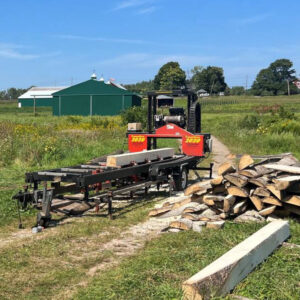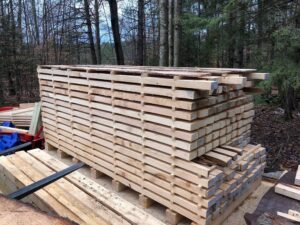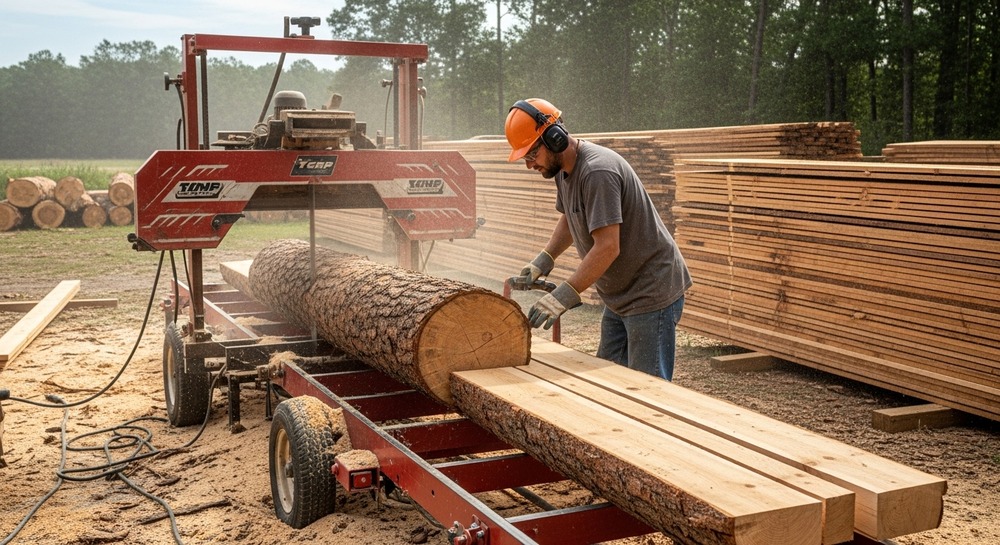Lumbering is a great way to recycle wood on your land, or purchase custom-cut wood to build, do woodworking, or furniture making. The average per board foot cost of milling is between 0.30 to 1.50 dollars, and extra costs are incurred in transporting, drying, and in the process of using planing. The price of milling lumber depends on a few factors, including the kind of milling being done, the size of logs, the area where it is done, the type of wood, and the way lumber is to be processed.
For professionals like framing estimators, understanding milling costs is essential when budgeting for custom framing materials or calculating lumber expenses in construction bids. By learning the deconstruction of these costs, homeowners, contractors, and woodworkers will be better informed to make informed decisions and budget successfully.
Types of Milling Services and Their Costs
- Portable Sawmilling (On-Site Milling)
The most common one is the portable sawmill, and this is mostly used by individuals desiring to cut lumber on their land. The contractor carries a mobile sawmill to the site and saws logs into boards there and then.
- Price: 65-120 dollars per hour, or 0.30-0.75 dollars per board foot.
- Pros: There is no necessity to buy logs; you can adapt the cuts, perfect to be use by a DIYer or a homesteader.
- Cons: Not as fast as the commercial operations, and labor-intensive.
- Commercial Sawmill Services
These sawmills are bigger and provide higher quality and efficiency in the processing of lumber in a professional manner.
- Price: per board foot (via services): 0.50 to 1.50.
- Pros: Quicker turnaround; Kiln drying and finishing commonly provided; ability to use specialty facilities.
- Cons: The transport of logs to the mill is necessary
- Chainsaw Milling
Chainsaw milling can also be used to cut smaller logs or custom-cut slabs such as live-edge boards.
- Cost: Typically $0.25 to $0.60 per board foot or $50–$100 per hour (if hiring a specialist).
- Advantages: Suitable for artistic or custom-cut, compact, and low-cost setups.
- Disadvantages: Time-consuming, more wasteful, less clean interpretations of cuts, tedious.
Key Cost Factors

- Log Size and Species
Bigger logs will be more difficult to deal with and will require more time to mill, particularly trees such as oak or walnut, which are hardwood.
- A blade wears on hardwoods and thus will need longer cutting speeds.
- Faster and cheaper are soft woods such as pine or cedar.
- Special handling and special equipment might be necessary, especially with logs of large diameters.
- Lumber Grade and Finish
When you order prepared lumber, planed, edged, or kiln-dried, every operation is profit-making.
- The lowest grade and most suitable for rustic or structural use are known as rough-cut boards.
- Planed or surfaced lumber is an addition of 0.20-0.50, which is $0.20-0.50 per board foot.
- The cost of kiln drying varies anywhere between 0.3 to 0.6 dollars/board foot, which is dependent upon species and percentage of moisture.
- Log Preparation and Handling
The logs are supposed to be straight, pruned, and clean of debris. There may be extra labor costs in the event the mill must take time to scale or relocate timber.
- The cost of trucking/hauling logs to a mill will be $100 500, depending on the distance and amount.
- Log cleaning or metal detector services can cost up to an extra 25-75 per log in order to prevent blade damage.
Example Cost Breakdown
Let’s say you have five large oak logs you want to mill into boards:
- Milling cost: 1,000 board feet × $0.75 = $750
- Planning and surfacing: 1,000 board feet × $0.30 = $300
- Kiln drying: 1,000 board feet × $0.50 = $500
- Transportation: $200
- Total Estimated Cost: $1,750 for 1,000 board feet → $1.75 per board foot total
This is still significantly cheaper than buying hardwood lumber from a retail store, which can range from $4 to $10 per board foot for similar wood.
Cost Comparison: Milling vs. Buying Lumber

| Type of Wood | Retail Cost per Board Foot | Milling Cost per Board Foot |
| Pine | $2 – $3 | $0.75 – $1.25 |
| Oak | $5 – $8 | $1.25 – $2.00 |
| Walnut | $8 – $12 | $2.00 – $2.75 |
Milling lumber from your logs is typically 40–70% cheaper than buying from a store, even after accounting for all processing steps.
Additional Services That Affect Cost
- Slab Cutting (live-edge boards): Adds $0.25–$0.50 per board foot.
- Metal Detection: $25–$75 per log
- Debarking: $20–$50 per log
- Custom Cuts or Patterns: Priced per request, often by the hour
Tips to Reduce Milling Costs
Prepare Logs in Advance
- Prune, clean up, and split logs into reasonable sizes.
- Keep off the ground by storing logs.
Bundle Multiple Logs for Processing
- Processing a large number of logs simultaneously cuts set-up costs and labor on an individual log.
Use Local Sawmillers
- When you hire a local portable sawmill operator, you do not have to spend money on hauling.
Sell Excess Lumber
- It is always cheaper to mill more than what you require so as to be able to sell your waste boards.
When Milling Is Not Cost-Effective
- Small volumes: On small volumes, retail lumber can be a better bet.
- Bad log quality: Lodged and rusty logs, decayed logs, or twisted ones can damage blades and lower the yield.
- No drying/storage: Premature milling of green wood that is not dried/stored correctly can warp or split, which lowers usability.
Hiring a Professional vs. DIY Milling
Your self-made mill (suitable as a chainsaw mill or band saw mill) reduces long-term cost; there may be a heavy price at the beginning.
- Chainsaw: $150 – $500
- Bandsaw mill 0-5 HP: $2000 – $6000
- Pro mill: $10000+
One-time and big projects are the best to hire a professional. They introduce expertise and equipment and are frequently capable of producing superior timber.
Conclusion
Depending on the service, wood species, location, and the finish desired, it can range anywhere between 0.30 and 1.50 board feet to have lumber milled. Milling will also require some cost at the front end, but it is usually far less expensive than buying finished lumber in retail shops. Custom milling is efficient, high-quality, and cost-effective, whether you are building a barn, making furniture, reclaiming trees on your land, or utilizing local logging operators or logs on your property.
FAQs
Is it cheaper to mill your lumber?
Yes. Milling lumber is 40–70% cheaper than buying from a store, especially if you have access to logs and you can mill in quantity.
How many board feet are in a log?
A 12-foot log that is 18 inches in diameter can potentially produce about 180-200 board feet, depending upon taper, cut, and waste.
Can I sell lumber milled from my trees?
Yes, a lot of people sell excess milled lumber, especially hardwoods, to recoup their milling charges. Look into local laws on timber sales if you think you will be selling commercially.

